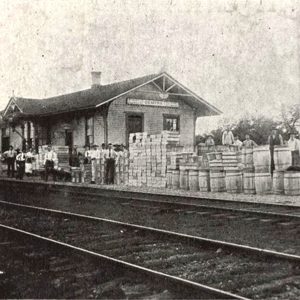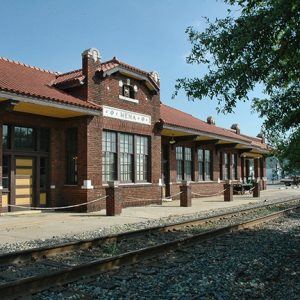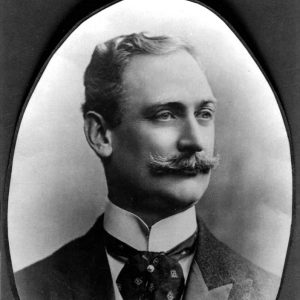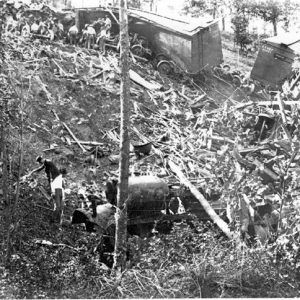calsfoundation@cals.org
Kansas City Southern Railway
aka: Canadian Pacific Kansas City Limited
The Kansas City Southern Railway Company (KCS), the smallest of the large North American freight railroads, had 4,300 miles of track in ten states. A predominantly north-south railroad in a world of east-west railroad systems, the KCS owned about 200 miles of track in western Arkansas along the border with Oklahoma. It continues to operate under the name Canadian Pacific Kansas City (CPKC) Limited.
Arthur E. Stilwell was the visionary who saw the need for a railroad to link the major agricultural center of Kansas City to a port on the Gulf of Mexico. In 1887, he built the Kansas City Suburban Belt Railway. It was a success, and Stilwell subsequently built two railroads south of Kansas City to serve mining areas for coal, lead, and zinc. In 1892, Stilwell purchased the Texarkana and Fort Smith Railroad, the main asset of which was a bridge across the Red River. Stilwell reorganized his rail properties under the name Kansas City, Pittsburg and Gulf Railroad (KCP&G) in 1892.
The next year, the KCP&G purchased the Kansas City, Fort Smith and Southern, which linked Joplin, Missouri, and Sulphur Springs (Benton County). The line, originally financed by Native American Matthias Splitlog, reached Sulphur Springs in 1889 but ran out of money. Given that the Panic of 1893 dried up sources of U.S. funding for railroad projects, Stilwell went to the Netherlands and secured financing that paid for an extension from Sulphur Springs to Siloam Springs (Benton County) in 1893.The KCP&G entered Indian Territory (present-day Oklahoma) as it pushed south and then re-entered Arkansas in 1896 when Mena (Polk County) was reached. The following year saw completion of track to the Arkansas-Texas border as well as construction in Texas and Louisiana. Service on the completed 786-mile line from Kansas City to Port Arthur, Texas, began on September 11, 1897.
The new line required additional equipment to handle the traffic. Stilwell had a financing deal with George Pullman, the American railroad car magnate. Pullman died before the deal was completed, and Stilwell lost control of the KCP&G. The railroad reorganized as the Kansas City Southern Railway Company in 1900. The 1901 discovery of oil in east Texas was a welcome traffic boost.
In 1898, the KCP&G built a sixteen-mile branch from Spiro, Indian Territory, to serve the important business center of Fort Smith (Sebastian County). The Fort Smith branch followed the Poteau River and repeatedly suffered from flooding. It was abandoned in 1943. The KCS arranged to enter Fort Smith by using the tracks of the St. Louis–San Francisco Railway (Frisco) at Poteau, Oklahoma. The KCS later purchased the 27.7 miles of former Frisco tracks to preserve freight service to Fort Smith customers. Fort Smith passenger train service ended in August 1941. A fleet of KCS buses then ferried Fort Smith passengers to and from Sallisaw, Oklahoma, until the 1969 end of passenger service.
In 1904, the KCS-owned Arkansas Western built a 31.7-mile line east from Heavener, Indian Territory, to Waldron (Scott County) to serve the timber industry. A twenty-three-mile southeasterly extension entered service in 1931 to serve a sawmill of the Caddo River Lumber Company at Forester (Scott County). The extension was abandoned in 1954, as the sawmill had ceased operation in 1952. A feed mill at Waldron is the major customer on the Waldron branch.
In 1939, Harvey Couch, a prominent Arkansas financier, became chairman of the KCS. The same year, the Louisiana and Arkansas Railway, headed by Couch’s brother, became part of the KCS. The Louisiana and Arkansas served the Baton Rouge, Louisiana, petrochemical area; New Orleans, Louisiana; and Dallas, Texas. Kansas City interests regained the KCS in May 1944, thus ending the control of Couch.
In 1940, the KCS introduced the Southern Belle, a diesel-powered streamlined day train between Kansas City, Missouri, and New Orleans. The Southern Belle received new equipment in 1948. The last KCS steam engine ran in 1951.
The former Graysonia, Nashville and Ashdown Railroad, a thirty-two-mile line from Ashdown (Little River County) to Nashville (Howard County), was acquired by the KCS in 1993. A cement plant is a major shipper. The Waldron and Nashville branches are leased to the Watco Companies, a short line operator based in Pittsburg, Kansas.
Unlike most railroads, the KCS retained a relatively positive view of passenger service in the 1960s. Although the passenger service lost money, the railroad felt it had an obligation to provide passenger service as long as there was reasonable patronage. It purchased used passenger equipment as other railroads fled passenger train losses. In 1965, the KCS purchased ten new passenger coaches, the last railroad car purchase by a private U.S. railroad. Much of the Kansas City to New Orleans area was devoid of interstate highways. The KCS offered low fares and reasonable dining car prices.
In the fall of 1967, the Post Office Department decided to eliminate railway post office (RPO) service on KCS trains and instead sort most mail in automated regional processing plants, with the remainder being transported in freight trains at freight rates. The loss of RPO revenue meant that KCS passenger train losses would soar from $2.9 million per annum to $4.4 million. REA, the express carrier, announced in early 1968 that it would no longer use KCS passenger trains for express business. The loss of REA traffic would deepen passenger train losses by $320,000 per annum.
In December 1967, the KCS applied for Interstate Commerce Commission authorization to discontinue all passenger service. In May 1968, approval to discontinue the Kansas City to Port Arthur trains was granted. However, continuance of Southern Belle service between Kansas City and New Orleans was deemed to be in the public interest. The Kansas City Southern passenger train losses worsened, and the Interstate Commerce Commission in 1969 authorized the discontinuation of the Southern Belle. The last run took place on November 3, 1969.
In 2023, the KCS merged with the Canadian Pacific Railroad to become the Canadian Pacific Kansas City (CPKC) Limited.
For additional information:
Arkansas Railroad Commission. Third Annual Report. Hot Springs, AR: Sentinel Record Press, 1903.
“Couch Made Head of Western Road.” New York Times, May 24, 1939.
Interstate Commerce Commission. Kansas City Southern Railway Company and Louisiana & Arkansas Railway Company Discontinuance of Trains Nos. 1 and 2. Between Kansas City, Mo., and New Orleans, La. ICC Reports 333. Washington DC: Government Printing Office, 1969.
Kansas City Southern Railway Company. “Diagram Showing Dates of Construction of Main Line and Branches.” Kansas City, MO: Office of Chief Engineer, February 16, 1912.
“M. L. Delafield in Couch’s Place.” New York Times, May 21, 1944.
Marre, Louis A. “About the Railroad Whose President Says ‘We Have No Intention of Going out of Passenger Business.’” Trains Magazine, November 1967, pp. 40–49.
Middleton, William D., George M. Smerk, Roberta M. Diehl, eds. Encyclopedia of North American Railroads. Bloomington: Indiana University Press, 2007.
“Twenty-Three Mile Extension to Arkansas Western is Completed.” Kansas City Southern Magazine, December 1930–January 1931, pp. 8–9.
Tom Duggan
Lowell, Arkansas











Comments
No comments on this entry yet.